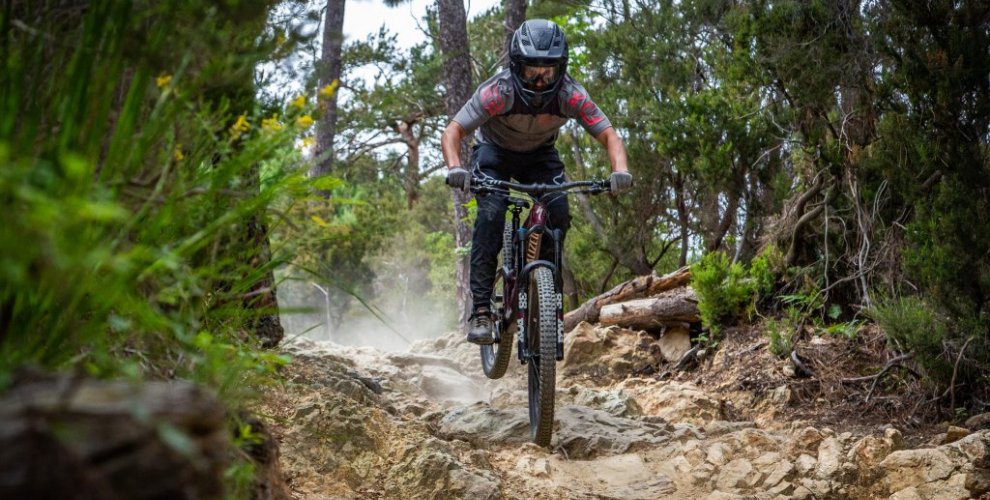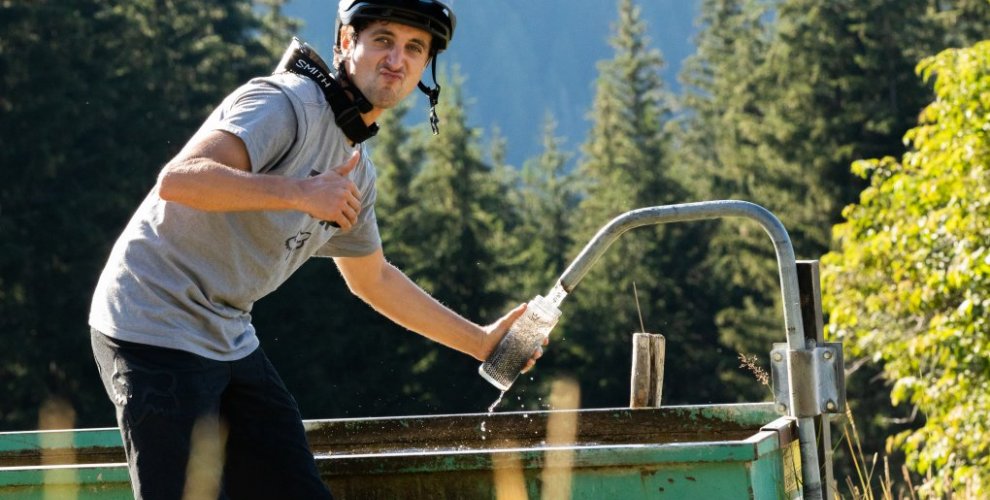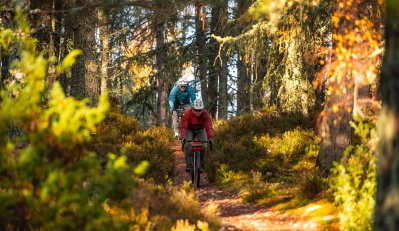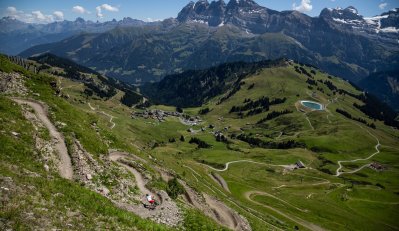Why do some riders get arm pump when others don't? Is there some kind of curse that befalls certain people that means they cannot hold on for more than afew minutes before pulling off to the side, gurning, wincing and holding their wrists in the hope it's all going to go away soon?
It's a constant on a mountain bike holiday in Morzine or Finale Ligure. Riders come back after a days riding physically drained from the effort of holding on. Now of course much of this is because in resorts like Morzine you can do a years worth of riding in a week, maybe more, it's hard on the body. But arm pump is something different, it kills the fun and no amount of rest will get rid of it. Sure, blame it on the braking bumps, they don't help but they are not the root cause. Moto GP riders get arm pump, there's no braking bumps on a race track....
Books have been written on the subject and people with far more medical expertise than us can talk about why some people get arm pump and others don't. There are many different ways to solve arm pump, some may be permanent, and some make you realise the problem wasn't your body after all, it was your bike.
A bigger question maybe are you experiencing arm pump, or fatigue? Are you just unfit or is there some underlying, easily solvable cause to your woes? We break down our experience with the issue and what we've done to help ourselves and clients over the years. Don't want to take our word for it, we've got professional MTB coach Chris Kilmurray involved, keep reading to help solve your arm pump forever!
Getting your setup right is the key to keeping thing together when it gets rough

REASON ONE - BAD GENES
Damn. You drew the short straw. Arm pump is caused when the tissue around the muscles in your arm do not expand with the muscle, as blood pumps to it during use. In some people it's simply not solvable without surgery. These cases are fringe and usually associated with athletes pushing their bodies to the limit, though because limits are subjective, it's an issue amateurs experience aswell.
Is there a way to alleviate the discomfort of arm pump without surgery? Yes. Put simply the first thing you can do if arm pump is an issue is look at your whole body. Pumping bicep curls and forearm twists will not help by themselves, but executing an all round program that makes you a stronger rider will make you whole body more capable, more flexible, more stable and this will take the pressure off those arms.
QUICK TIPS TO FIX GENETIC ISSUES WITH ARM PUMP?
Get a professional coach that specifically understands mountain biking or a similar sport (such as motocross) to build a fitness program for you. If it's really bad and prohibitive, see a doctor.
REASON TWO - BIKE SETUP
This is the most important in our eyes, as it's instant. You set your bike up however you like, if it works for you crack on. But if you're suffering out there and if you want to get stable, comfortable and centered on the bike, key to so many other things including arm fatigue or even arm pump.
Put simply, your body position on the bike should be centered and everything you do to setup your bike should be focused on this. Extreme positions when on steep terrain, drops, or climbing should not change this principle. You may see riders setting their front end high with headset spacers or higher rise bars, but this is to maintain that centered position when riding steep trails consistently.
WHAT YOU DOING WRONG IN SETTING UP THE BIKE?
Could be nothing, could be a whole lot.
Reach. Sweet Jesus this has gotten out of hand. If you are tall, as in 185cm plus, 525mm of reach is probably good, if you're 170cm on a good day, then it ain't. Everything is in proportional, if you're short on a long bike, you're going to look silly and it's going to compromise your riding. If you're tall, riding a short bike then you'll look like the Peaty and Minnaar in 2003. The reach number on a frame is not the be all and end all. The entire frame and bike needs to be in balance with your body.
Handlebars also have a big role to play, too wide and they will stretch and strain muscles that do not need to be stretched or strained just to maintain a riding position. The material can play a part too, carbon bars may be the difference with their ability help absorb bumps, though some maybe wouldn't notice a difference.
Don't know how wide to have your bars? Stand up, arms by your side, lift them out to your side like you're a plane at 90 degrees. Then rotate your forearms at the elbow forwards 90 degrees again, with both arms. Have someone measure the distance from the inside of your elbow joints. Whatever that is, no wider than that, and not much slimmer.
The angle of your brake lever, lever throw, and lever reach maybe the single biggest immediate change you can make to your bike to stop arm fatigue. Think of your body as one inter-connected chain, while the pain maybe in your forearms, from the tip of your finger to the shoulder joint muscles and tendons are working to dictate the strength and endurance you have to not simply hang on but to perform.
Your grips. They should not be too thick or too thin. They should be what fits your hand the best, and there is no one size fits all. In our opinion ergonomically designed grips can cause problems both in terms of function but also adaptability, making you rely on the equipment rather than your own body to maintain good form.
Suspension. Are you too soft or too firm, too fast or slow? You won't get anything right until you have your sag correct. Do this as per the manual on your bike or suspension product and stay within those parameters. It is all about setting the bike up balanced, you can try and be clever by working those dials, pressures or spring rates but deviate from a good, balanced bike with correct sag and you'll cause a host of knock on problems for your riding. Check this guide we put together for suspension setup.

QUICK TIPS FOR BIKE SETUP TO REDUCE ARM FATIGUE
Brake levers. Undo them and let them drop down. Sit on the bike. Place your hands on the handlebar, close your eyes and stick your braking finger out. That's where your lever should be, where your finger goes. You'll find when you stand in a riding position your forearm, arm and shoulder will make an almost direct straight line, no funny joints or kinks, at the wrist will be a slight bend to, your hand will press into the grip, this aids support. Your braking finger will be roughly at the same angle as your hand, deviate a little either way for preference.
Lever throw, in this attack position, your finger should rest naturally on the lever and not stretch at all to sit there, ready brake. You should not apply any pressure while riding, unless you are braking of course. Simply rest the finger on the lever, applying pressure is causing excess strain.
You should be braking with one finger only, if you two finger brake it's going to hurt, if you have to jam the brakes on constantly just to get to work it will hurt.
If the above is not possible with your brakes, change them if you want to reduce arm fatigue. They should be comfortable, easy to modulate, adjustable and powerful. Again, no one size fits all, it is preference, every brake is different, but get this bit right. You cannot go fast if you cannot slow down.
A session with a good bike coach will do your riding wonders. It's probably the single best thing you can spend your money on. Body position and key points to help you maintain it will help your energy levels enormously.
REASON THREE - YOU'RE NOT FIT AND NOT RIDING ENOUGH
If you sit at a desk all week, do nothing in the evenings other than eat dinner, sink afew beers and watch TV, you aren't fit. Heading to the local for afew laps on a Sunday is not going to help solve the arm pump issues and neither is shifting weights in the gym alone. It may get the blood flowing but it does little for your muscle memory, when you get to Morzine and are confronted with 6 full days of chairlift assisted laps it's gonna sting.
Muscle memory is great, for your purposes as an amateur rider it's more important than big, rippling biceps and rock hard forearms. You can be built like The Rock and still get arm fatigue lapping Pleney. That's because your muscles get strong for the jobs they are asked to do. Gym work will build great definition and strength and can be an important part of being better on the bike. But, actually getting the time on the bike in is a more important part of helping you overcome being able to hold on, there is no better tool and no piece of gym equipment can replicate it.
More time on the bike, particularly over rough terrain and over extended periods will help you gain better technique across your whole body, and help your arms get used to the strain of being worked in that manner.
A training program maybe useful if you are trying to push your riding to the next level. It can improve your physique and give you the strength to maintain a good riding position for longer, aswell as be more aggressive. Legs, core, shoulders all directly relate to arm fatigue in some way and yet do not involve direct arm exercises. If you find the gymn a real chore, get out on your bike! A piece of kit like a Praep bar can help bridge the gap between the two and give you a decent work out and feel like you've done something to benefit your riding.
QUICK TIPS TO GET FIT ON A BIKE
Ride more, challenge yourself when you do. Ride with more experienced riders and learn from them. Take each piece of knowledge with a pinch of salt until you hear the same thing afew times, when you do that thing is probably correct and you should be seeing if it works for you.
Further to that, a fitness program that you can stick to will certainly help you progress on the bike.
REASON FOUR - LINE CHOICE & CARRYING SPEED
If braking bumps hurt, why are you plowing into them? If the trail is rough and beaten up, what are you doing about it?
Line choice is absolutely key, and you can do something about it on your very next ride. Look up. This is number 1, 2 and 3 on most pro coaches' agenda when it comes to your riding technique and is key to line choice. Plan the trail ahead, your body will be prepared for what is coming and you can start to see efficient ways to negotiate the track.
Sam Hill is the perfect example of efficiency. His line choice is not all about the inside of every turn, it's about the most efficient way to get down the hill, this is not only fast in terms of distance travelled but also in keeping energy levels up. By riding his own track he'll often be out of the chunder and bumps, on a high or low line, on untouched dirt, keeping him fresh.
It is harder to go slow over rough terrain than it is to go fast. Going slowly the bike will struggle to work at it's optimum and your body has to make more conscious efforts to maintain a safe and stable riding position. The longer you are on the trail, the harder this becomes as you tire. Put simply, try and pick up the pace.
Build your confidence. Rather than letting off the brakes on your nearest black run, start smooth and keep going, ride a variety of terrain to build your base knowledge of how your body and bike will react to different ground conditions.
QUICK TIPS TO IMPROVE YOUR LINE CHOICE
Look up look up look up look up look up look up.
Ride with riders who are better than you, not necessarily fast but technically better. The best guide we've employed was not amazingly fast,or strong, but she could out last any client through smart line choice, smooth riding and a solid body position.
Drink water

REASON FIVE - DIET
Eat better.
If you eat junk, you will feel like junk.
The way you eat will have an impact on your energy levels and the way your body and mind functions. If you've read this far fatigue is a thing for you, so have a look at what it is you consume on a weekly basis. If you struggle with your diet and want to improve it, some professional advice to better your habits.
This is especially relevant for when you are out shredding laps on holiday. You're on holiday, enjoy yourself. But if you are suffering, that pint, burger and chips is not going to make it any easier. Be aware of how you are feeling and try to make smarter choices. If you go good on burgers and pizzas, then you crack on.
Of course if you are staying with us on a fully catered Riders Week in Morzine or Finale Ligure, a chef is on hand preparing breakfast and dinner, healthy and nutritious. The same applies to our tours with Tom Hutton MTB and our own Scottish tours, you'll never go hungry in Aosta either!
QUICK TIPS TO HELP YOUR DIET
Get some professional advice from a recognised nutritionist or coach. Start cooking your own food and find a balance that works for you, that you can stick to.
SUMMARY
If you struggle with arm pump or even general fatigue this whole article will help you overcome it. Some fixes are very quick, almost instant and you could put them into practice today, some will take more time.
This isn't about lining up at the next world Cup, this about allowing you to have more fun on the bike while on holiday.
- CHECK YOU SETUP - Brake lever positioning, handlebar width, cockpit length
- LOOK UP - Read the trail, take smoother lines, make smarter choices
- WATCH YOUR DIET - Eat and drink bad, you'll feel bad
- RIDE YOUR BIKE MORE - The more you ride, the better you will ride
- PUT EFFORT INTO YOUR FITNESS - Your arms will work better when your whole body does
The man on speed dial for many of the worlds top gravity racers, Chris Kilmurray of Point1 Athletic puts an enormous amount of time and effort into understanding the relationship between bike and body;
BALANCE
No I don't mean bouncy balls and gadgets. I mean your weight distribution between front and rear wheels! This along with a few factors already covered in this article form the foundation for a relative arm-pump free ride. Arm pump comes in a few forms, the classic hard and swollen forearms that stop you gripping the bars, braking with accuracy and steering is known as "acute exertional compartment syndrome" ; basically a whole lot of blood and fluids in the forearm and no room between muscle, connective tissue & fascia! Things get more grey when we talk about hand cramp or more neurological symptoms where fingers go numb or hands stop working due to sheer pain! These symptoms are often from vibrations, dreaded chatter or breaking bumps. What about balance then you ask? Well, a correctly set up bike that supports your weight in all dynamic riding moves, especially under braking is critical, it's the foundation from which you can then work on techniques like better braking, changes like lever angle or through and components like different grip widths or densities! Frame, wheel and fork stiffness matter too but these are expensive changes. .
SUSPENSION
Dial in front and rear sag (via spring rate) it's the first step always, too soft is worse than too stiff for arm-pump, but the sweet-spot is easy to find. Next is rebound, when I see your average rider on holidays in Morzine their suspension is most often too slow AND soft. Rapid rebound and balanced spring rates are a life changer. Next is compression setting, you need support with LSC for bike park berms, but not so much that the fork is dead and your arms have to work harder. Embrace finding your suspension sweet spot and arm-pump might disappear.
STRENGTH
Strong and healthy shoulders, along with a strong buttocks and quadriceps will allow you to ride the bike using your legs when needed and arms as needed. Not what I often see on trail. Usually riders who suffer from arm pump tend to squat and not hinge and create torque or tension with the arms and shoulders by pulling elbows towards the midline. These both cause you to grip the bars like you're on a roller coaster with no seatbelt! Not ideal. So get those shoulders strong and legs even stronger.
DIET
From a purely physical POV eating enough and hydrating regularly when riding demanding tracks in warm weather is obvious enough. But the cognitive impact will also play a massive role in arm-pump, once the brain slows you start to read the trails and tracks in a different way, making poor line and direction decisions and braking longer and harder than needed. All aggravating arm-pump. Eat like a champ and drink like a fish! - Learn a track - we all love to explore, but sometimes it's the unknown of a track that causes arm issues, so try riding a track back to back 3-5 times, learning the lines and places on track to brake and re-direct. If this solves your arm-pump to a degree then you need to improve your anticipation and focus to really beat the dreaded arm blues. -
COCKPIT
Bar material, width and stem stiffness along with tyre pressure and wheel construction can all play a role in arm issues. Start with thinner grips and well bled brakes if you have forearm issues. If hand cramp is your worry then aim for better padded grips, alloy bars in narrower diameters and aluminium wheels!
SUMMARY
So my top arm-pump tips are based around the swiftest and most effective changes you can make. Remember, just like a top racer, it's one change at a time and you need plenty of runs on tracks that push your limits or cause arm-pump symptoms to really feel the effects. These changes with well set-up suspension can change lives or holidays
Though alot to digest, hopefully there's enough in here to help you get the most out of riding whether at home or abroad, get after it!
#ONEPEDALAHEAD











